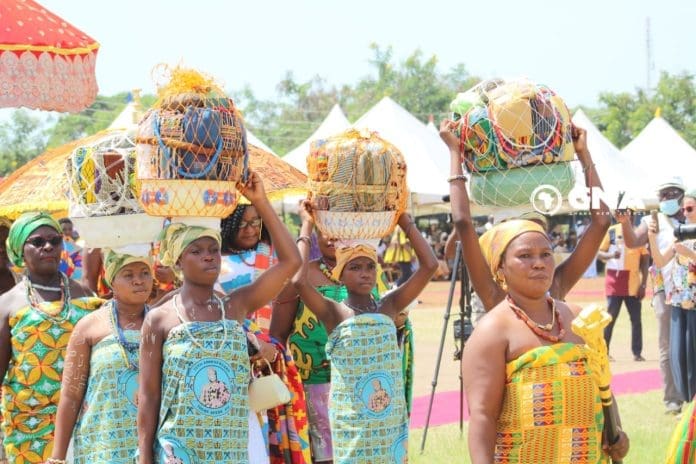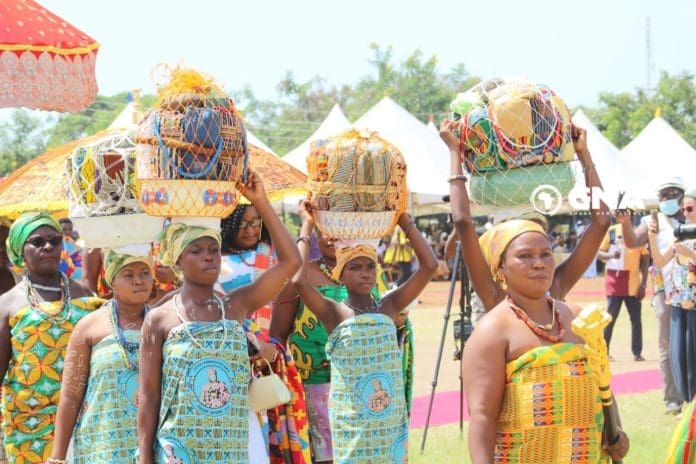
The 2025 edition of Hogbetsotso Za reached its grand climax on Saturday, November 1, transforming the Anloga to Keta corridor into a vibrant celebration of culture, history, and community that’s delivering significant economic benefits to the Volta Region.
Under the theme “Building Bridges: From a Common History to a Common Destiny,” this year’s festival has drawn thousands of visitors both local and from abroad to witness one of Ghana’s most prestigious cultural celebrations. The streets and durbar grounds buzzed with colour, music, and the steady beat of drums as the Anlo people commemorated their ancestors’ historic exodus from Notsie in present day Togo.
The festival’s centerpiece, the Grand Durbar at Hogbe Park in Anloga, brought together prominent traditional leaders including Togbi Sri III, Awoamefia of Anlo, and special guest Odeneho Kwafo Akoto III, Akwamuhene. The Akwamuhene’s attendance sent a powerful message of peace and collaboration between the Anlo and Akwamu states, embodying this year’s theme of building bridges across communities.
Togbi Agbesi Awusu II, Awadada of Anlo, joined other dignitaries in highlighting how cultural celebrations like Hogbetsotso Za serve as platforms for regional development beyond their traditional significance. The Awadada has consistently emphasized that such events complement education, infrastructure, and youth empowerment initiatives.
Spectators were treated to the dramatic Glimetoto reenactment on October 31, which vividly portrayed how the Anlo people escaped from Notsie and settled in their present homeland. The historical exodus performance reminded citizens of their ancestral journey and the courage of their forefathers who fled tyrannical rule by walking backwards through the city walls.
The Agbadza dance, with its intricate steps and hypnotic drum rhythms, filled public squares and ceremonial grounds throughout the festival week. Children’s durbars held on October 29 across various circuit capitals, unity concerts, and the Mama Hogbe Beauty Pageant at Jubilee Radio premises in Keta added layers of energy and engagement, giving families and youth a strong sense of pride in their heritage.
This year’s festival has proven to be more than just a cultural landmark. It’s generating substantial economic activity across the region. Hotels and guesthouses along the Anloga to Keta stretch are fully booked, with accommodation providers reporting unprecedented demand. Restaurants and pubs are experiencing brisk business as visitors seek local culinary experiences.
Petty traders selling traditional foods, drinks, crafts, and souvenirs are enjoying strong sales throughout the festival period. Musical concerts, arts showcases, and roadshows in Woe, Keta, and Adidome have created temporary employment for transport operators, performers, and event staff while driving increased demand for local goods and services.
Local business owners are already projecting that this year’s celebrations will generate significant revenue, reinforcing Hogbetsotso Za’s reputation as a major boost for regional commerce. The festival’s impact extends beyond Anloga itself, with activities spread across multiple towns creating ripple effects that benefit traders, artisans, and service providers throughout the corridor.
The week long programme began on October 25 with a mini Hogbe durbar at Adidome in the Central Tongu District. On October 30, the festival featured symbolic activities including community net casting from Fuveme to Keta at dawn, Nugbidodo reconciliation rites at Agorwowornu, and a vibrant Agbadza street carnival with a procession from Atorkor to Hogbe Park.
October 31 packed in major events starting with a health walk from Jubilee Radio premises in Keta at 5 a.m., followed by the Awoamefia sitting in state at his residence in Woe to welcome visitors. The day also featured the Volta Economic Forum at Reddington Hotel in Whuti at midday, bringing together stakeholders to discuss regional development opportunities.
The festival’s planning committee, working in collaboration with the Anlo Dukor Council and Ghana Exim Bank, has successfully delivered a rich blend of traditional rituals, educational forums, entertainment, and thanksgiving activities. Kennet Kpedor, a member of the Central Planning Committee, explained that this year’s celebration aims to strengthen cultural ties, deepen inter ethnic understanding, and promote collective development among Ghana’s traditional communities.
The Awadada of Anlo has used the festival platform to advocate for transforming Ohawu Agricultural College into a university, arguing that such an upgrade would create new opportunities in agriculture, research, and employment while promoting agricultural innovation and food security for the region.
Over the years, Hogbetsotso Za has evolved into one of Ghana’s most prestigious festivals, attracting visitors from across the nation and the diaspora. The celebration commemorates events from the 15th century when the Anlo people fled Notsie and settled along Ghana’s coastal belt between the Volta estuary, the Atlantic Ocean, and the Keta Lagoon.
The festival has traditionally served multiple purposes beyond cultural celebration. It includes purification ceremonies of traditional stools and general cleaning when villages are swept and rubbish burned. This cleaning ceremony begins at the Volta Estuary and continues for days until reaching the Mono River in Benin.
Religious cults including the Korku and Yewe cults display their traditions through magical performances during the festival. The Korku cult members famously demonstrate their spiritual powers by cutting themselves with sharp knives without effect, captivating audiences with these traditional displays.
As Sunday’s beach party at Emancipation Beach in Keta extends the celebrations, and inter faith thanksgiving services prepare to conclude the festival week from November 3 to 9, the impact of Hogbetsotso Za 2025 is already clear. The festival has successfully blended traditional heritage with contemporary entertainment, cultural education with economic opportunity, and local pride with regional cooperation.
The mix of colourful regalia, traditional music, lively dancing, and the presence of chiefs and dignitaries perfectly captures what makes Hogbetsotso Za significant for the Anlo people. It’s a living celebration of history, a demonstration of unity across communities, and a catalyst for economic activity, all coming together in a weekend that locals and visitors will remember for years to come.
For the Volta Region’s tourism sector, the festival demonstrates the economic potential of cultural celebrations when properly organized and promoted. As accommodation providers, restaurant owners, and traders tally their revenues from this year’s edition, the business case for investing in cultural tourism infrastructure becomes increasingly compelling.
The 2025 Hogbetsotso Za has once again proven that preserving cultural heritage and driving economic development aren’t competing priorities. When executed thoughtfully, traditional festivals can honour the past while building prosperity for the future, strengthening both cultural identity and community livelihoods in equal measure.
